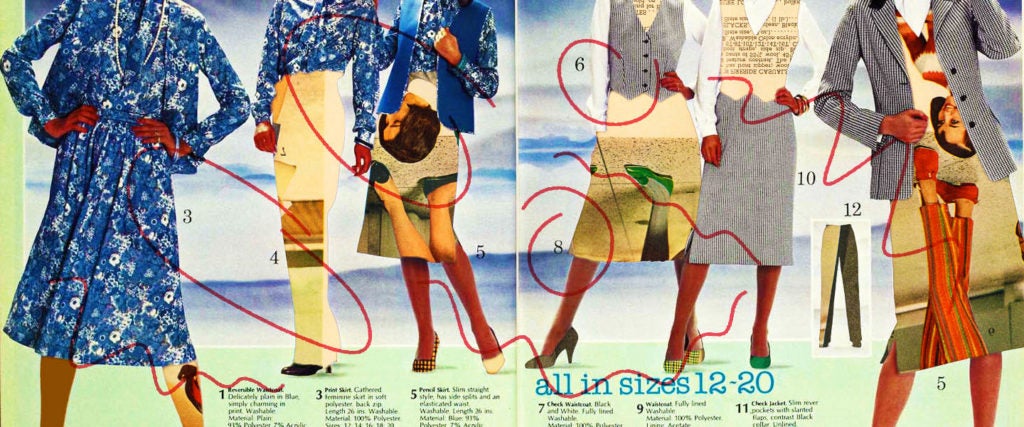In the early aughts, catalogs gave 7-year-old Candace hope that she’d one day have a catalog lifestyle — something that seemed impossible in her unstable home. In particular, she became obsessed with the Apartment Guide, a grocery store freebie that showcased local real estate, hoping for a nice studio or one-bedroom that she could call her own. She’d go so far as to pick out soulless late 1990s/early aughts decor for it, like halogen lamps and uncomfortable sofas. Meanwhile, JCPenney and Sears catalogs were reserved for her career wardrobe, while the Limited Too and Hollister ones were for weekend attire.
“It was a coping mechanism for sure,” Candace, now 26, tells me. “In order to survive my childhood, I lived in the future. Planning for a place that was just mine made me hopeful for my future. It was also a vision board before I knew what vision boards were.”
Along those lines, long before the dawn of Instagram and Pinterest, there were catalogs, the old-school version of filling up your online shopping cart with stuff you knew full well you were never gonna actually buy. Whether it was, like for Candace, a coping mechanism or an outlet for self-expression, the comfort that catalogs brought for many was the ultimate self-soothing activity. And although most have replaced catalogs with obsessing over cottagecore accounts on Instagram, the nostalgia of their catalog days still makes a lot of people feel deeply emotional and grateful.
For me, it was the Spiegel catalog. I scoured every edition for the furnishings and household goods I’d need when I reached my ultimate goal — turning 18 and moving out on my own. I was a 1980s child who frequently drowned out the sounds of a sometimes violent household with images of white French Provincial furniture. It was a hope for a better life — or at least a bed that wasn’t just a mattress on the floor.
Carly Mance, a licensed therapist who specializes in trauma recovery, says this coping mechanism is called Traumatic Dissociative Avoidance, a common response to abuse that involves frequent fantasies and daydreaming. “When there’s no external locus of control (my external is chaos, distressing, abusive and sad, and there’s nothing I can do about it), we find an internal one (something I can do on my own to feel in control),” she explains. “It also can be about escape or just an innocuous, healthy way to be creative.”
Speaking of escape, for 41-year-old Jacob, the Sears Wish Book represented “pure escapism.” “It made you believe obtaining things would give you that perfect life and make people like you,” he tells me. “We didn’t have the internet, and in my case, we didn’t even have cable. Catalogs were it.”
Jacob is so sentimental about the Sears Wish Book that he still peruses sites that offer scanned copies. “Websites to this day cannot touch one of these catalogs,” he argues. “Bookmarking a web page that will eventually be deleted just isn’t the same.”
Stephanie, a 34-year-old in the U.K., was notorious in her family for ruining every catalog and magazine that came through the door, circling everything she wanted with a heavy, black pen. “I was, and am, rather tacky, and this gave me an opportunity to be tasteless and embarrassing in preparation for how I imagined I’d live my adult life,” she says. “The aspect that was most therapeutic for me was simply ridding myself of the anxious feeling of wanting something like cheap, chunky-heeled pleather sandals without having to point it out to my mum or sisters and let them know that I thought it was good.”
For others, however, the fantasy catalog world was a family tradition. Sara, a 39-year-old in Brooklyn, picked up the habit from her grandmother. “She wanted to cultivate a ‘taste’ for nice things in me. She grew up poor, so class was always on her mind,” she says. “She really taught me many not-so-great coping skills like secret eating, binge-watching soap operas and being very attuned to what material stuff I should be aspiring to own. The Spiegel catalog was more about fantasy and aspiration, though. It was like another level of happiness to achieve.”
These days, Mance thinks, much like catalogs, social media has capitalized on the specific reward centers of our brain that need instant gratification. And while there are instances of these obsessions actually interfering with our lives, for the most part, Mance finds them to be harmless — and in some cases, beneficial. This is backed up by numerous studies showing that Pinterest specifically helps people deal with chronic pain and cope with stress.
“I have a large, organized Pinterest board, and I use it as a de-stresser,” Candace says. “Sometimes at night, I just get on my iPad and browse Pinterest to unwind. I went to a therapist a few years ago who explained how that ‘living in the future’ was what was able to get me through some of the worst parts of my childhood. Now I think I use Pinterest and online window shopping to fill that void.”
I swear, though, they still can’t hold a candle to the Spiegel catalog.

